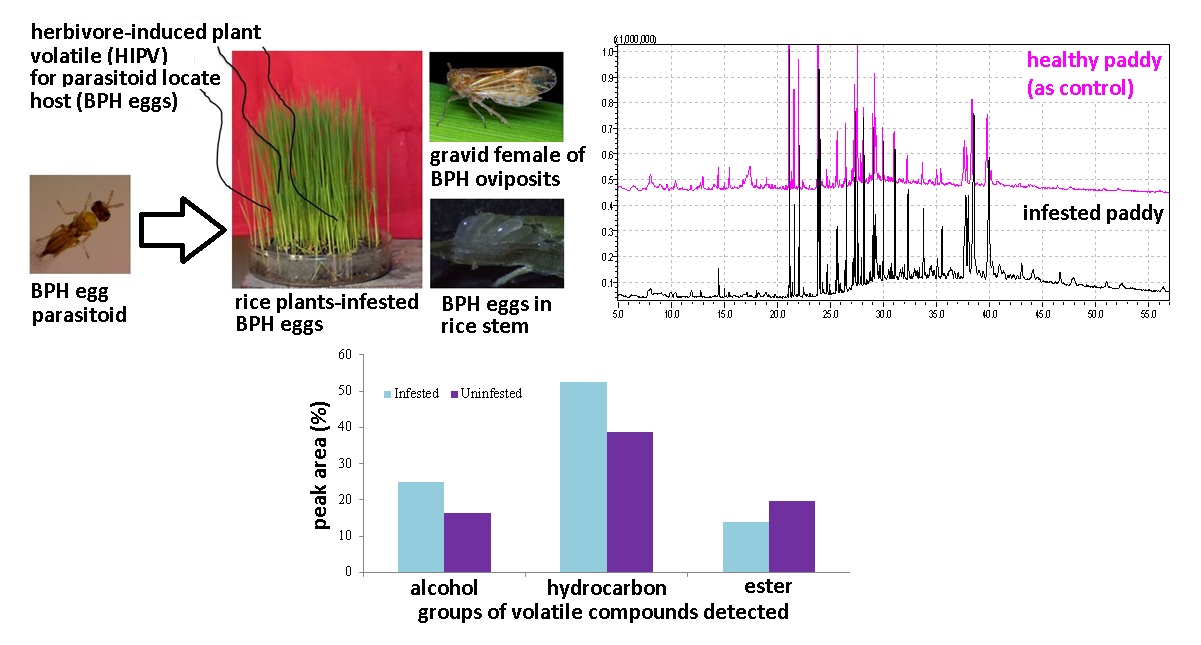Chemical Cues in Tritrophic Interaction on Biocontrol of Insect Pest
Abstract

Tritrophic interaction among host plant-herbivore-parasitoid involves chemical cues. The infested plant by herbivores has been reacted to produce volatiles which is a cue used by the herbivore parasitoids for host location. These volatiles can be developed to enhance natural control of insect pests, especially by optimally use of parasitoids. Egg parasitoids are biocontrol agents that play an important role in natural control of herbivores. This research used a tritrophic interaction model of rice plant-brown plant hopper (BPH)-egg parasitoid of BPH. Research on analysis of chemical cues in tritrophic interactions was aimed to identify volatiles that are used by the parasitoid to find its host. The volatiles that effectively affect the parasitoid orientation behavior could be developed into a parasitoid attractant. Extraction of volatiles as the egg parasitoid cues was done using soxhlet, and identification of the volatiles using Gas Chromatography-Mass Spectrometry (GC-MS). Bioassay of the volatiles on the BPH parasitoid orientation behavior was performed using Y-tube olfactometry. The volatiles that are used for host location cues by the parasitoid affect the parasitoid orientation behavior by showing the preference of the parasitoid females to the odor of volatile. Volatiles extracted from BPH-egg-infested plants and uninfested plants contain alcohol, hydrocarbon, and ester compounds. Based on the difference of the compound composition of both extractions, five compounds of long-chain hydrocarbon, both branched and unsaturated compounds are the main volatile components which caused positive orientation behavior of the egg parasitoid. The egg parasitoids showed positive behavior orientation toward the volatiles extracted from BPH-egg-infested plant. Those hydrocarbon compounds are potential materials to be developed into bio attractants of BPH egg parasitoid.
References
[1] Riyals, J., Uknes, S., Ward, E. Plant Physiol. 1994, 104, 1109–1112.
[2] Green, T.R., Ryan, C. A. Science. 1972, 175, 776–777.
[3] Paré, P. W., Tumlinson, J. . Plant Physiol. 1999, 121, 325–331.
[4] Peña-Cortés H., P., B., F., D., Polanco, V., Sánchez, C., Sánchez, E., Ramírez, I. J. Plant Growth Regul. 2005, 23, 246–260.
[5] Thaler, J. S., Stout, M. J., Karban, R., G., D. Ecol. Entomol. 2001, 26, 312–324.
[6] Tebayashi, S. I., Horibata, Y., Mikagi, E., T Kashiwagi, Mekuria, D. B., Dekebo, A., Ishihara, A., Kim, C. S. Biosci. Biotechnol. Biochem. 2007, 71, 1521–1526.
[7] Senthil-Nathan, S., Kalaivani, K., Man-Young, C., Chae-Hon, P. Pestic. Biochem. Physiol. 2009, 95, 77–84.
[8] Constabel, C. A., Ryan, C. A. Phytochemistry 1998, 47, 507–511.
[9] Lu, Y., Wang, X., Lou, Y., Cheng, J. Chinese Sci. Bull. 2006, 51 (20), 2457–2465.
[10] Wonorahardjo, S., Nurindah, Sunarto, D. A., Sujak, Zakia, N. JEI, 2015, 12 (1), 48–57.
[11] Lou, Y.-G., Ma, B., Cheng, J.-A. J. Chem. Ecol. 2005, 31 (10), 2357–2372.
[12] Meilin, A. Dampak Aplikasi Insektisida pada Parasitoid Telur Wereng Batang Coklat dan Deltametrin Konsentrasi sublethal terhadap Anagrus nilaparvatae (Hymenoptera: Mymaridae ), Disertasi, Universitas Gajah Mada, 2012.
[13] Lin, J.-Y., Fan, W., Gao, Y.-N., Wu, S.-F., Wang, S.-X. 10th Int. Work. Conf. Stored Prod. Prot. 2010, 125–134.
[14] Lou, Y., Cheng, J. Entomol. J. East China 1996, 5, 60–64.
[15] Rapusas, H. R., Bottrell, D. G., Coll, M. Biol. Control 1996, 6, 394–400.
Refbacks
- There are currently no refbacks.

This work is licensed under a Creative Commons Attribution-NonCommercial 4.0 International License.








